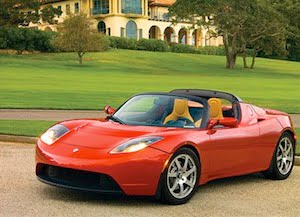A Tale of Two IPOs
 The stock of electric car company Tesla Motors (TSLA) has been more breathtaking to watch than one of its expensive $100,000+ roadsters that I happened to come across earlier this week near the post office in my city. Following its June 29 IPO priced at $17, the stock hit a high of $30.42 the next day before promptly losing more than half its value the following week, bottoming just under $15. The stock currently trades 17% above its IPO price at $19.89. While a lot of attention has been focused on this money losing yet promising company that is backed by a $465 million government loan, a $50 million investment by Toyota Motor (TM), a $50 million investment by Daimler and top tier silicon valley VCs, investors who have a strong stomach for volatility should probably revisit another company that went public earlier this year. This company saw its stock close 44% above its IPO price on its first day of trading when compared to Tesla’s 40% opening day pop.
The stock of electric car company Tesla Motors (TSLA) has been more breathtaking to watch than one of its expensive $100,000+ roadsters that I happened to come across earlier this week near the post office in my city. Following its June 29 IPO priced at $17, the stock hit a high of $30.42 the next day before promptly losing more than half its value the following week, bottoming just under $15. The stock currently trades 17% above its IPO price at $19.89. While a lot of attention has been focused on this money losing yet promising company that is backed by a $465 million government loan, a $50 million investment by Toyota Motor (TM), a $50 million investment by Daimler and top tier silicon valley VCs, investors who have a strong stomach for volatility should probably revisit another company that went public earlier this year. This company saw its stock close 44% above its IPO price on its first day of trading when compared to Tesla’s 40% opening day pop.
This company is profitable, has a proven business model and one of its founders is a Nobel laureate. Financial Engines (FNGN) priced its IPO at $12 per share in March of this year and currently trades about 11% above its IPO price at $13.42. The company has a disruptive yet proven business model where it uses technology to offer portfolio management services and investment advice. Given the importance of asset allocation to portfolio returns as discussed in our October 2008 newsletter, William Sharpe, Professor of Finance, Emeritus at Stanford University and winner of the 1990 Noble Prize in Economics decided to start Financial Engines in 1996 and use technology to offer sophisticated investment advice to individuals regardless of their wealth or investment experience.
While the average client balance for the top 100 traditional Registered Investment Advisors (RIAs) is over $1 million, the average size of a portfolio managed by Financial Engines is $72,000. In fact 43% of the portfolios managed by the company have less than $20,000 in them. Despite the low average portfolio size, Financial Engines has almost $30 billion in assets under management (AUM) as of the first quarter of 2010. Their technology based solution and partnerships with several large employers to offer advice to 401K participants has helped the company scale AUM effectively from $6 billion in 2006 to $30 billion now. The company has partnerships with 115 of the Fortune 500 companies and has signed up over 360 employers in total.
Growth:
The company has a three pronged growth strategy:
1. Grow Assets Under Contract (AUC), which are currently $289 billion, by signing on more employers, organic growth through ongoing contributions by existing 401K participants, market appreciation, net new hires by employers and a shift towards automatically enrolling employees in 401K plans.
2. Grow Assets Under Management (AUM) by increasing enrollment by 401K participants from employers under contract who have not signed on yet.
3. Entering new markets by going beyond 401Ks and into IRA.
Q1 2010 Results:
Revenue in the first quarter of 2010 increased 40% year-over-year to $24.3 million. Net income increased to $1.6 million in Q1 2010 when compared to a loss of $0.7 million in Q1 2009. Non-GAAP Adjusted EBITDA for Q1 2010 increased 130% year-over-year to $5.3 million. However due to a one-time $5.5 million stock dividend, net loss attributable to shareholders was $3.9 million or 25 cents a share.
Valuation:
Financial Engines expects to post revenue of $105 to $110 million in 2010 and adjusted EBITDA of $24 to $26 million. Using the mid-point of their EBITDA range and the current enterprise value of $448 million, I get a EV/EBITDA value of 18. The EV/Revenue ratio works out to 4.17. The company expects long-term EPS growth of 25 to 40% at operating margins of 15 to 20%.
Running a 10 year DCF model using a 10% discount rate, 20% earnings growth for 10 years and a 2% terminal rate, I get a current value of $23.54 for the stock. If you are a growth investor, Financial Engines should definitely be on your watch list and may provide a less risky alternative to Tesla Motors.
Related Reading:
